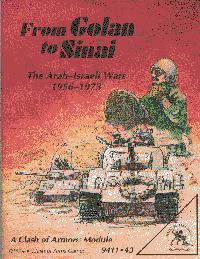

A complete description of the game system can be found by reading our web page about the original game in the series, Clash of Armor.
A description of this supplement (From Golan To Sinai) is also available.
David Sullivan (dasulliv@mv.us.adobe.com) writes:
It's great. Ever since I read Moshe Dayan's "Diary of the Sinai Campaign" in 1970, I've been waiting for someone to put out a rule set that covers this specific conflict. It's surprising to me that the war which has generated the largest tank battles in the 20th century (with the exception of Kursk) has been so long relegated to an inferior status to the hypothetical WW3 gaming that seem to be such a big part of other post-WW2 rules (I have yet to see data from Command Decision on the Arab-Israeli wars). Since I've waited so long, I'm glad it's Clash of Armor that's done it.
Since it uses the same command activation system as Clash of Armor, From Golan to Sinai is an excellent set for this conflict. The huge differential between Arab and Israeli tactical proficiency stands out significantly and enables small Israeli units to put up a good fight against numerically superior Arab forces, but the fight can still be costly if not disastrous depending on how well the Israeli player uses the command superiority he has.
The scenarios are a good selection of the conflicts. Alhough there are no 1948 scenarios, the data is available to create them with a little imaginative modification (in fact, if the figures were available, this would be an excellent set of rules for doing the War of Independence battles around Jerusalem in 15mm or 20mm). The scenarios that come with it are a very good mix of armor vs. armor and armor vs. infantry. They are not exhaustive since, short as they were, the conflicts in 1956, 1967 and 1973 offer a wealth of material for scenario building -- especially 1973 with the numerous huge tank battles in the Sinai, and the Israeli drive on Damascus where they smacked into the allied troops from Iraq and Jordan (the elite 40th tank brigade). Other interesting scenarios could be a what-if (almost) war between Jordan and Syria over Jordan's "Black September" ousting of the PLO in 1969.
Clash of Armor has its own unique perspective that does a terrific simulation of modern tactical warfare. Applied to the Arab-Israeli conflict, this set of rules really brings out the issues that make command control all important. I highly recommend both the period for gaming and Clash of Armor/From Golan to Sinai as the rules to use for it.
If you would like to add your opinion to this webpage, use the following form or send email to the editor.
| Last Updates | |
|---|---|
| 5 April 1997 | reorganized |
| 15 April 1996 | reorganized |
| 10 April 1995 | first published |
| Comments or corrections? | |